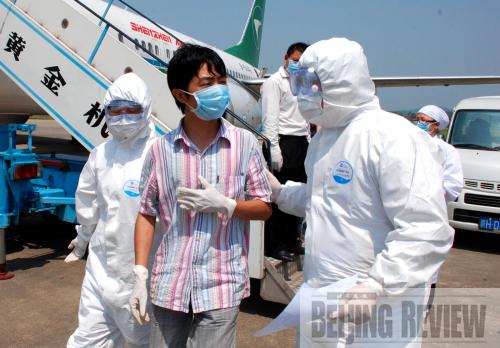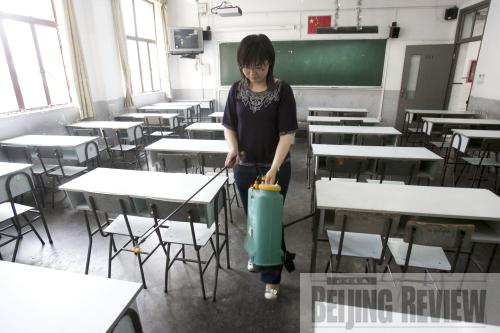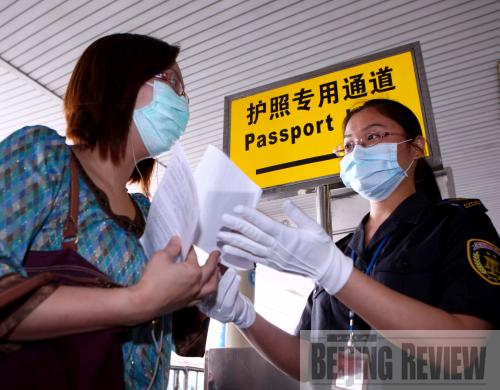|
 |
|
WAR GAME: Staff from Jiangxi Province's Jingdezhen First Aid Center practice how to safely and quickly send a suspected A/H1N1 patient to the hospital on June 4 (ZHU DINGWEN) |
With new A/H1N1 flu cases spreading around the world every day, criticism over China's alleged overreaction to this new virus may finally be dying out. But leaders acknowledged the country is not in the clear yet. The arduous challenges of developing vaccines and preventing any large-scale outbreaks still lay ahead.
World Health Organization (WHO) Director General Margaret Chan announced at a briefing on June 11 that the WHO is raising the A/H1N1 pandemic alert level to six, the agency's highest alert level, which means the world is in the early days of the first influenza pandemic of the 21st century.
Chan suggested that governments adjust their public health response to the pandemic to the development of the outbreak in their country. But she also emphasized that pandemic means geographical spread, not severity."We also want to make clear that the higher level of the pandemic does not necessarily mean we are going to see a more dangerous virus or see many more people falling severely ill or dying," she said.
Since it first surfaced in Mexico and the United States, the new virus has quickly spread to Britain, Spain, Japan, Australia and Chile, meeting the WHO's pandemic definition of the sustained community spread of a novel virus in two different WHO regions.
Chan said her agency continues to advise against travel restrictions and that the WHO would work with the World Trade Organization and others to ensure nations do not impose travel and trade bans over the A/H1N1 virus.
Since the first Chinese mainland A/H1N1 case was confirmed on May 11, a total of 125 cases had been found in 11 municipalities and provinces, including Beijing and Shanghai, by June 11.
Vigorous measures
To curb the spread of the virus, China has stepped up inspection and quarantine measures at airports where all passengers will have their body temperatures tested. Passengers with a fever will be sent to hospitals for medical observation.
From May 18, a new version of the health declaration card for inbound and outbound passengers came into use in ports all across China to help track passengers in close contact with A/H1N1 patients.
Inbound passengers are now required to provide detailed information on their stay in China, including where they plan to go and their flight seat numbers. Passengers who stay in China for less than a week are also required to report their departure dates, destination countries and flight and seat numbers. They are now also asked to report if they develop either a runny or a stuffed nose or fatigue in addition to the previous request to report more serious flu symptoms.
The Civil Aviation Administration of China set guidelines requiring that one member of the crew serve a feverish passenger for the duration of a flight. People sitting in the same row as the sick passenger and those sitting three rows in front of and behind the infected person are required to put on masks and eat separately. The sick person is to be immediately reported to disease control authorities.
The Ministry of Health issued three regulations on May 11 to set guidelines on monitoring the virus, quarantining people in close contact with A/H1N1 patients and sterilizing places that may be contaminated.
The monitoring regulations apply to the current limited spread of the virus through imported cases and sporadic non-imported cases, which can be tracked. Once sustained community spread appears in China, which is a situation that will be declared by Ministry of Health experts, the focus of the country's monitoring regime will change from diagnosing and reporting individual cases to analyzing the damage and epidemic level of the virus and its demands on medical resources.
Disease control and prevention organizations and medical institutions are obliged to report any possible or confirmed A/H1N1 case by putting the information into an online national disease monitoring and reporting system database within two hours. Organizations without Internet access are to call or fax to report the cases to county-level disease control and prevention authorities within two hours.
Medical officials should have virus samples from a province's first suspected A/H1N1 case tested and checked by the Chinese Center for Disease Control and Prevention before an expert panel under the Ministry of Health confirms and announces the results.
According to the regulations, people in close contact with A/H1N1 patients are those who diagnosed, treated or visited patients without effective protection; people who lived with or had close contact with patients; or people who had been exposed to patients' respiratory secretions, body fluids or an environment contaminated by the patients.
Much at stake
Speaking at a forum on June 2, Health Minister Chen Zhu explained why China has taken vigorous measures to prevent the spread of A/H1N1 flu. Chen said the two major reasons are the risk of disastrous effects should the virus mutate and the gained time that is being used for vaccine development.
"If a virus spreads widely in the population, the risk of its mutation will grow larger," said Chen. Besides the possibility of seasonal flu outbreaks, China has been warned by the WHO that its location in East Asia, on the migration routes of various birds, imparts a higher risk of harboring A/H1N1 virus mutations. The H5N1 avian flu virus is highly pathogenic but not very contagious. The A/H1N1 virus is just the opposite. If these two viruses combine, the result could be disastrous, according to Chen.
Chen also said, historically, that global influenza pandemics usually attack the population in three waves. The world is currently going through the first wave of a potential A/H1N1 influenza pandemic, he said. When the 1918 influenza pandemic virus was first reported in the spring of that year, it did not kill many. But between October and November 1918, the virus became much deadlier. By the third wave, which didn't appear until 1919, it had become highly lethal.
China is trying to beat the clock to develop and produce vaccines against the A/H1N1 virus, Chen said. "Our vigorous inspection and quarantine measures are to win time for China to achieve technical breakthroughs, make sure there are adequate supplies of medicine and develop vaccines. It is our contribution to the global prevention campaign."
The minister stressed that China has not overreacted since it has nationwide college entrance exams and high school entrance exams in June. It has to make sure that when students go back home for summer vacations, there are no sustained outbreaks in communities. That is why China has activated a monitoring system in communities. The second wave might hit China in November. China is very concerned about the virus's spread in the southern hemisphere since it is winter down there. If the A/H1N1 virus combined with the seasonal influenza virus, the second wave could come even earlier, Chen said.
Huang Jianshi, a disease control professor with Beijing Union Medical College, echoed Chen's opinions. During a June 3 China Central Television (CCTV) interview, Huang said China cannot afford to lower its guard against A/H1N1 outbreaks due to its huge population and living density. Huang said China must adopt stricter preventive measures compared to other countries. He said China has a vulnerable population of over 500 million who can easily develop flu complications, including patients with chronic diseases, senior citizens over the age of 60, children under the age of 14 and some 50 million pregnant women.
He said compared to the United States, Chinese living conditions are poorer overall and residential density is much higher, which poses special challenges to the country's plans to control the spread of A/H1N1. Huang said China should be alarmed by the damage caused by the flu in Japan, where 4,000 schools were forced to shut down and 1.44 million students had to stay home. This, he said, was the result of Japan's ineffective disease control efforts.
"Under our correct disease control guidelines, the hard work of our medical community has been repaid with social stability and the protection of our vulnerable population," Huang said.
Vaccine development
China has 11 flu vaccine manufacturers, but only one, Beijing-based Sinovac Biotech Co., is qualified to produce pandemic vaccines. Pandemic flu is rare, meaning that it's hard for people to develop resistance and vaccine doses need to be higher to be effective. Sinovac received the flu strain samples on June 8.
Hualan Biological Engineering Inc. is qualified to make seasonal flu vaccines, which use lower doses because people have developed resistance to seasonal flu over generations.
Hualan was the first Chinese vaccine company to receive A/H1N1 seed viruses, isolated viral strains used to make vaccines, from WHO on June 3 and the company started development that night.
On June 9, Sinovac announced it would share key techniques and cooperate with other flu vaccine producers in a bid to rapidly expand vaccine production.
On the same day, the State Food and Drug Administration (SFDA) held a press conference announcing it would organize and coordinate the 11 drug companies as they produce vaccines in case the A/ H1N1 virus turns into a pandemic.
Yin Hongzhang, head of the State Food and Drug Administration's biology production department, ensured that the vaccines, which will be directly injected into high-risk populations, would be available in October. He noted that safety and efficacy experiments are still necessary before batch production begins.
"Given that the A/H1N1 virus is new and yet to be well understood, we'll deploy staff to oversee the entire process of the vaccine's research and development, production, testing, distribution and final use," said SFDA Spokeswoman Yan Jiangying.
Yin said four or five of the qualified vaccine manufacturers in China have received virus samples to produce a vaccine from the WHO and the remaining companies would receive samples by June 14.
Yin said that since China has 11 of the 32 qualified A/H1N1 vaccine producers in the world, the country has made a commitment to producing enough for both domestic demand and for the WHO, should it be necessary.
In an interview with CCTV, Dong Xiaoping, a senior official with the Chinese Center for Disease Control and Prevention, said it is up to WHO to decide whether A/H1N1 is a seasonal flu or a global pandemic. Dong said the total annual 360-million-dose production capacity of China's 11 flu vaccine manufacturers would be sufficient to meet its own demand if A/H1N1 is classified as a seasonal flu. If the outbreak is upgraded to a global pandemic, he said, a totally different vaccine should be put into production, for which only one company in China is qualified to produce it. Under such circumstances, to meet the gap between supply and demand, the Chinese Government will need to coordinate production between all the country's flu vaccine manufacturers.
Lessons from SARS
The Chinese Government has mounted "a very robust response" to the A/H1N1 influenza threat and its efforts are paying off, the WHO head said on May 28 from Geneva.
"The Ministry of Health, under the coordination of government leaders, mounted a very robust response so that they are able to track down all the cases," Chan told Xinhua in an interview. "So far the efforts are paying off."
Hans Troedsson, the WHO representative in China, wrote in China Daily on May 21, "At the national level, China offers a good example of how far we have come on disease control since the SARS (Severe Acute Respiratory Syndromes) outbreak in 2003."
Troedsson wrote that the flow of information between WHO and the Chinese Ministry of Health has been swift and transparent, with daily calls and meetings to exchange information on global and national developments.
He also spoke highly of China's high-level commitment to preventing and controlling the spread of A/H1N1 in the country. In May, eight working groups were set up with officials from the ministries of health, agriculture, science and technology, foreign affairs and commerce, and agencies like the Chinese Center for Disease Control and Prevention and the General Administration of Quality Supervision, Inspection and Quarantine. These groups have been given separate responsibilities in monitoring ports for imported cases, researching and developing related technologies, treating patients and conducting international exchanges, among others.
Based on the experiences and lessons learned from the SARS, the State Council issued the new Regulation on Public Health Emergency Response in May 2003 to strengthen surveillance for new disease outbreaks and to improve reporting and response between agencies. The regulation for the first time clearly stated that the deadline for reporting cases to the higher authorities during a possible major epidemic should be no more than two hours, rather than using words like "immediately" or "in time," as was previously written in laws.
The regulation also for the first time created a national reporting telephone number, strengthened the national information network and enabled non-infected areas to take prevention measures in time.
Since the end of 2005, Ministry of Health emergency response offices have been located in health departments in 27 provinces, autonomous regions and municipalities across China.
The country's public health emergency response system was activated on April 28, after the WHO informed the Chinese Ministry of Health about the North American A/H1N1 outbreak.
China immediately enhanced its surveillance system and alerted healthcare workers at all levels to report any unusual influenza-like symptoms.
"China's experience shows that the same actions and responses can be applied to different types of emerging infectious diseases such as pandemic flu. Long-term investments in preparedness do pay off," wrote Troedsson.
 |
|
FREE FROM FLU: A Shanghai teacher sterilizes a classroom on the eve of China's national college entrance exams, which start on June 7 (ZHANG DONG) |
 |
|
KEEPING GUARD: A port inspector (right) in Shenzhen, Guangdong Province, checks a passenger's health declaration card. The province activated its public health emergency response system on May 19 after four A/H1N1 cases were confirmed (CHEN JIANLI) |
 |
| ANTI-FLU AID: The first load of relief supplies donated by China are transported on April 30 from Beijing to Mexico to help it battle an outbreak of A/H1N1 flu (JIN LEI) |
 |
| FEVER DETECTOR: Airport staff in Jinan, Shandong Province, use an infrared camera to test passengers' body temperatures (ZHU ZHENG) |
| 